?
Akira Shimizu - Designs for City Monuments

Shimizu designed monuments models for two City Design Projects. One is for Shinjuku in the metropolitan area of Tokyo, and the other for Amakusa, the islands in Kumamoto of Kyushu in the southern part of Japan. In these designs, he attempts to install new color and meaning in the cities. Although these designs never came into fruition, Shimizu was successful in finding an answer to his own theme, the relationship between humans and nature.
Amakusa Project
Amakusa islands belong to Kumamoto Prefecture of the Kyushu region,@the third largest and southernmost of the four major islands of Japan. Its surface is very hilly and the area contains scenic spots including Amakusa-Matushima, which was sung about by the famous Japanese poet of the Meiji Period (1868-1912), Akiko Yosano. Amakusa Islands are made up of about 100 large and small islands including two large ones, Kamijima and Shimojima. Amakusa Gokyo (Five Big Bridges), opened to traffic in 1966, has played important roles in making this area attractive to sightseers.
The Project, the Amakusa Area Sightseeing Recreation Center Construction Plan, announced in 1984, aimed to make the coastal area of Itsuwa-town of Amakusa, the northern part of the biggest island of Amakusa, the strategic development center for sightseeing. The project included:
- the design for the Ocean Viewing Tower
- the Boardwalk in the Ocean, that is supposed to appear on the ebb tide
- the Park for fishing
- the Beach
- the Museum
- the Culture Center
Shimizu played an important role in designing the monuments which are a new feature of the Amakusa Area, and this was called gThe Amakusa Projecth.
Although this project did not come into fruition, it was planned in detail, consisting of installation of 5 monuments to be installed on the 4 km long coastline of the Port of Itsuwa-cho. Letfs take a look at the design of each monument.
With regard to several symbols that are repeatedly used in his designs, please refer to Shimizu's Iconography Page.
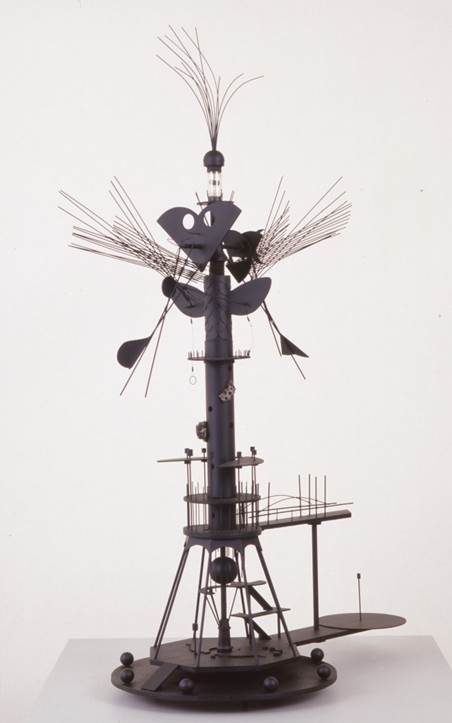
Subaru(the Pleiades)
1984
Wood, bamboo sticks, plastic, floating wreckage, glass, wire and lacquer
142.0 X 101.0 x 48.5 cm (H X W X L)
This is a model for a complex of an ocean viewing tower, a lighthouse and a museum to be constructed 500 meters off the seashore. It is connected to the land by a bridge and people can walk to this tower. Several benches and illuminations were designed for the museumfs outer space, and so was a spiral staircase in the underground level so that people can walk down to the sea level at low tide.
In this design, Shimizu uses various symbols of opposing objects like man and woman, the sun and the moon, as well as things associated with the ocean such as the parts of a ship, a seagull, a claw of a crab and the arms of an octopus.
The cylindrical body symbolizes an ancient firing device and is meant to be a genital of a man, and the oval shape at the middle symbolizes a genital of a woman. The combination of the genitals means birth. There is, however, a claw of a crab at the lower part, which is going to cut the body and it means death. This tower embodies the combination of the opposing entities, and this is Shimizufs expression of harmony.
He also aimed to express the juxtaposition of time and space, and he installed the following symbols on both sides of the main body:
- a rudder plate of a boat that is suspended from the sun
- a symbol of a tail of a seagull, suspended from the moon
#1 is intended to embody a scene in which a fishing boat returns to the bay at sunrise, while #2 embodies a scene in which a seagull flies to the ocean at sunset.
The complex was named Subaru, meaning the Pleiades, or Seven Sisters. Since the ancient periods in Japan, Subaru has been written about repeatedly in poems, and its meaning is harmony and unification.
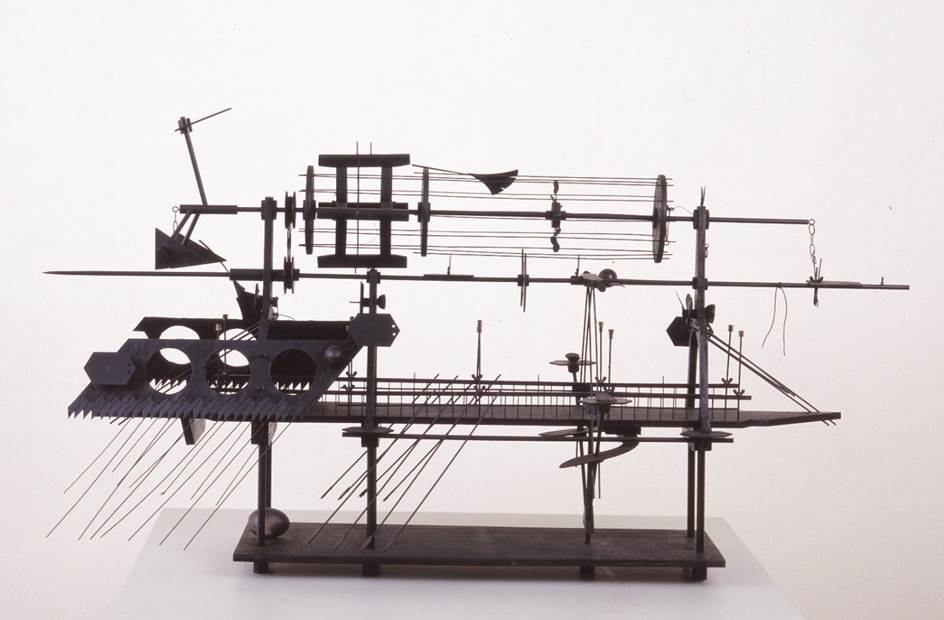
Kamejima-Ohashi (Bridge over Kamejima Island)
1984
Wood, bamboo sticks, plastic, floating wreckage, glass, wire and lacquer
70.0 X 142.0 x 52.0 cm (H X W X L) (Right Tower)
56.5 X 62.0 x 27.0 cm (H X W X L) (Center Tower)
57.0 X 62.5 x 26.0 cm (H X W X L) (Left Tower)
Kamejima-Ohashi is the bridge that is to be built from Kamejima Island to the port of Oniike. Ryugu Bridge is designed for about one third length of this bridge, and there is a walking deck at the middle layer of the bridge. At the upper layer there is also Maikiri (a firing device) that symbolizes the genital of men, and in the upper side there is a mixture of Japanese drum with 13 bowstrings, a spinning wheel and water. The combination is meant to spin round, and the author aims to make musical sound out of this structure. However, paradoxically as it is too, there is an anchor (the three triangles) to stop it. At the lower layer, there are one pair of carapaces (of turtle), four pairs of oar and four pair of ribs of Dragons (the parallel sticks).The concept of ribs of Dragons originated from the name of a historic place in this area, and also means serials of rocks that appear in the ebb tide. There is an egg of turtle under this bridge, and it is supposed to appear in ebb tide. Shimizu says gNumber of young turtles will gather in this bridge to become a huge turtle that eventually evolves into Kamejima Island (Kame means turtle, and jima means island in Japanese.)
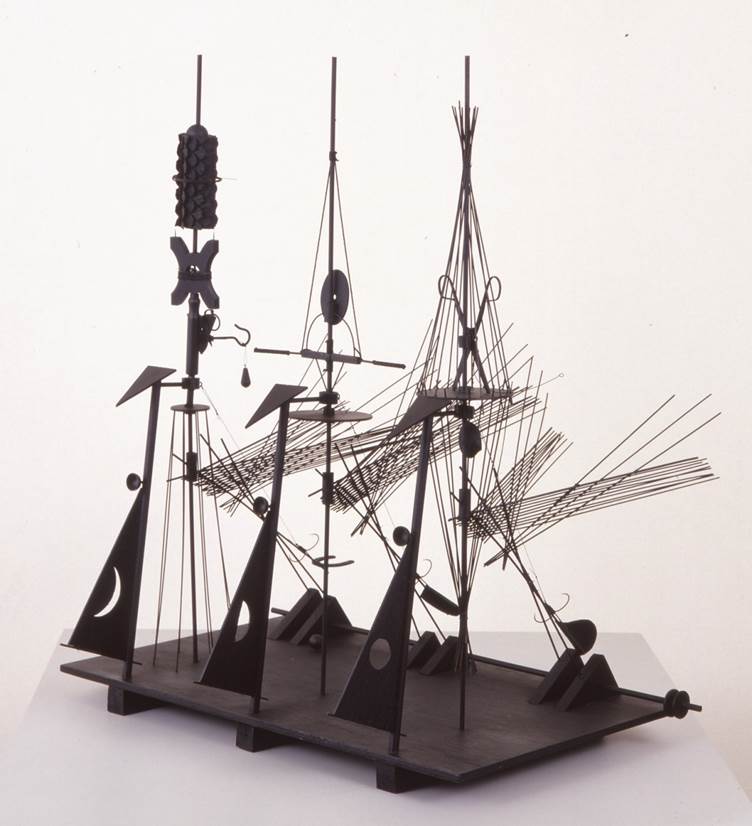
Pegasus with shooting stars catchers
1984
Wood, bamboo sticks, plastic, floating wreckage, glass, wire and lacquer
86.0 X 63.0 x 79.0 cm (H X W X L)
This monument is to be constructed in the ocean. The three big pillars and masts mean a boat. Each pillar has a small hemisphere that is meant to catch shooting stars. This boat is inspired by the image of Namban-sen, Western ships that came in Muromachi and Edo periods (about 15 - 19 A.D.). The full moon, half moon and the crescent shape that are cut out in the masts mean the departure or desire to eternity. In the opposite sides of masts, there are a horse hoof, tail of seagull and rudder. The pillar with a pair of scissors is meant to water and women. The center pillar in the shape of firing device is meant to fire and men. The third pillar has fish, reel and heart (two semicircles that are intersected) symbols in upper part and a horse hoof in the back, and this pillar is meant to Pegasus that embodies eternal soul.
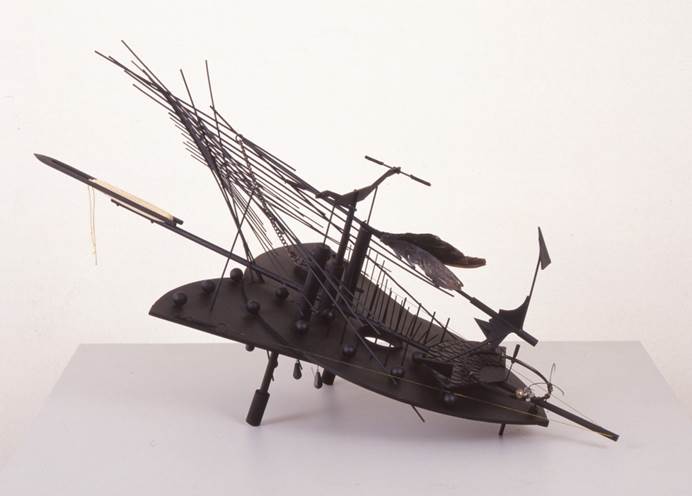
The Full Moon Shooter
1984
Wood, bamboo sticks, plastic, floating wreckage, glass, wire and lacquer
52.0 X 102.0 x 51.0 cm (H X W X L)
This monument is to be also constructed in the ocean. The whole tilting body has a function to shoot the full moon. The two semicircles that are crossed are meant to heart. An arrow is going to be shot to the moon from this bow. The arrow means fire and man, and the heart means water and women.
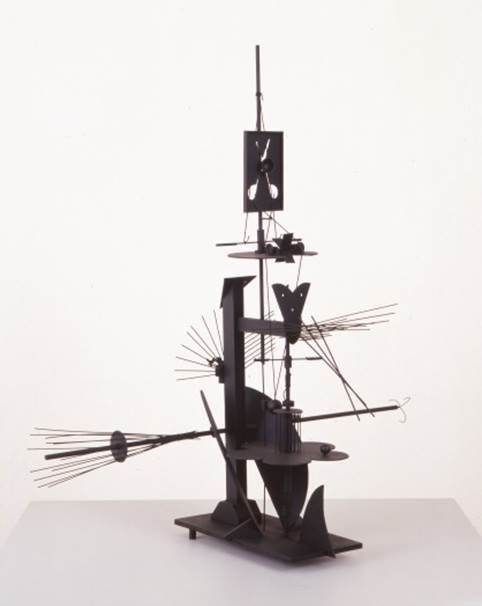
Ocean Camellia
1984
Wood, bamboo sticks, plastic, floating wreckage, glass, wire and lacquer
101.5 X 93.0 x 56.0 cm (H X W X L)
This monument is to be also constructed in the ocean. Seen from the upper air there is a flower (camellia) at the bottom and two pillars grow from the center. A dorsal fin at the bottom means a shark, and it aims to catch the flower. There is a cutting of a pair of scissors at the pillar, which means it is ghish house and gheh has gone to outside. The other pillar means winch of a fishing boat. The oval shape at the bottom is a genital of a woman, and being winched, it turns to fox, and at the end turns to scissors.
Shinjuku Project
"Shinjuku Projects" refers designs for streets around the new Tokyo metropolitan government buildings, which were under construction at that time(1988). In 1988, Tokyo Metropolitan Government summarized the survey report for Shinjuku sub-central road scenery development.
Specifically, streets and avenues in the vicinity of the Tokyo Metropolitan Government buildings that were under construction at the time were to be built in a pedestrian-centered space. The architect, Masaharu Takasaki proposed the establishment of "Citi Walls" for the avenues from Shinjuku Station to the Tokyo Metropolitan Government and the continuous pedestrian space. Shimizu proposed four monuments of "Symbol Bridges" at the four intersections close to the new Government building. This "Four Symbol Bridges" are called "Shinjuku project".
Shimizu named each design for the Symbol Bridges, Spring, Summer, Autumn and Winter space.
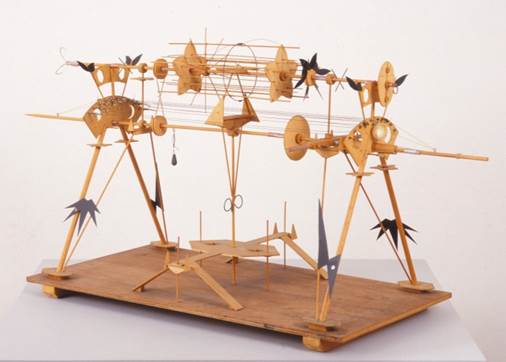
Monument Design - Spring (Shinjuku Project)
1988
Wood, bamboo sticks, plastic and wire
66.0 X 128.5 X 45.5 cm (H X W X L)
In the "Spring Square" there is a viewing square of the stage shaped like a turtle shell at a height of 4.5 meters above the ground. There are two stages of sculptures to cover over the viewing square. There is a horizontally attached pump drill and a pair of scissors to cut it in the lower sculpture, and as a whole it represents the koto of the instrument. The windmill rotates in the upper row, and it also works with scissors. A narcissus flower, plum blossoms, bamboo leaves are scattered as seasonal plants.

Monument Design - Summer (Shinjuku Project)
1988
Wood, bamboo sticks, plastic and wire
61.5 X 124.0 X 47.0 cm (H X W X L)
"Summer Square" has a viewing square of the shell type stage. A horizontally placed pillar represents a flute, and a water wheel (two conical shapes) rotates over the pillar. Leaves of iris and pine, morning glories are scattered as seasonal plants.
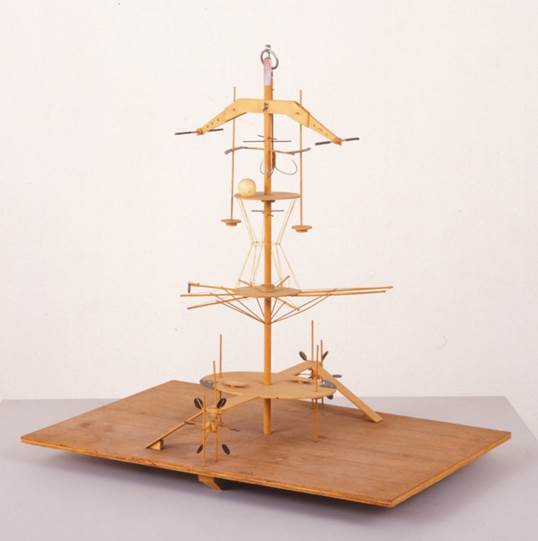
Monument Design - Autumn (Shinjuku Project)
1988
Wood, bamboo sticks, plastic and wire
72.0 X 70.0 X 50.0 cm (H X W X L)
"Fall Square" "Winter Square" are symbol bridges of almost the same type facing Tokyo Metro Street. In the "Fall Square" there is a viewing square on the deformation stage of the ellipse at the bottom, and the water wheels turn on both sides. At the middle height there is a drum. The seasonal plants are autumn leaves.
@
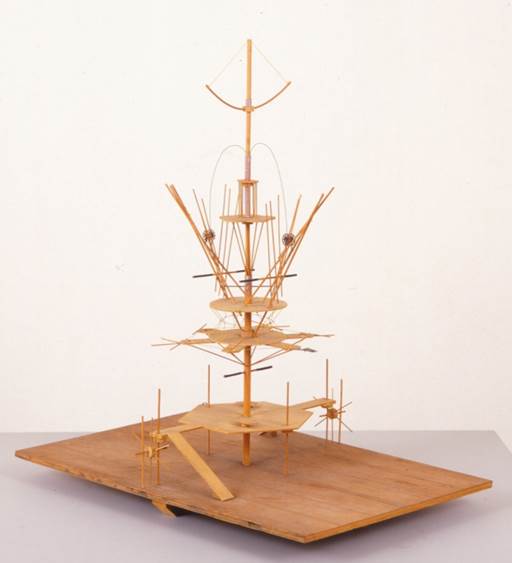
Monument Design - Winter (Shinjuku Project)
1988
Wood, bamboo sticks, plastic and wire
77.0 X 70.0 X 48.0 cm (H X W X L)
In the "Winter Square" there is a view square in the snow stage, with the handle of the flood gate on both sides of it. A pillar rises from the center of the square, and there are two small drums in the middle, an well drilling pump over it and a bow is installed at the top. The seasonal flower is a camellia.
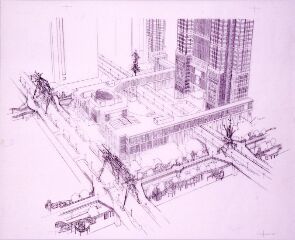
Complete View Design for Shinjuku Project
1988
Pencil, Tracing Paper
59.0 X 84.0 cm (H X W X L)
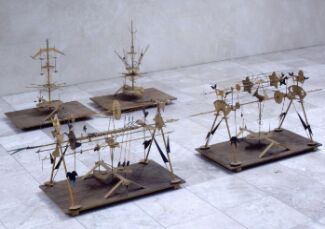
Monument Designs(Shinjuku Project)
From front right corner clockwise, Spring, Summer, Autumn, Winter
1988
Wood, bamboo sticks, plastic and wire
Spring - 66.0 X 128.5 X 45.5 cm (H X W X L)
Summer - 61.5 X 124.0 X 47.0 cm@(H X W X L)
Autumn - 72.0 X 70.0 X 50.0 cm@(H X W X L)
Winter - 77.0 X 70.0 X 48.0 cm@(H X W X L)
As you may be aware from the aforementioned explanations, the basic concept of the four symbol bridges is "Birth and Ascension" and love for the four seasons. gBirth and Ascensionh is expressed by interlocking of life and termination, symbolized by a pump drill (men), a water wheel(women), a pump(women) and a pair of scissors. This gBirth and Ascensionh is also the basic concept of Amakusa Project.
Addendum
In early 1980's, Shimizu got acquainted with Shigeru Miyashita, Yoji Makino and Akito Hasebe, city development planners, who happened to visit Shimizu's solo exhibition "From the Darkness" series in Gallery Shunju in Tokyo. Overwhelmed by the dynamism of his objects, they had an idea to use his works as monuments in the city development plans. Thus, Shimizu designed models for two city projects.
Besides the Amakusa and the Shinjuku Project introduced in this page, they worked together for a tourism promotion event for Toshima Island, a village island located in Oshima subprefecture, Tokyo Metropolis as well as several development plans including that for Omiya Station West Square. Among them, the event of Toshima has been realized, but other projects have not yet been realized.
Nonetheless, the concept proposed by Shimizu and the planners is asking. How can we plant a flower and get it bloom in peoplefs mind? It may be an eternal theme for us. And it is undeniable that Shimizu was aiming to create the unique thing rooted in Japanese culture. I hope these city monument plans will be realized in some way somewhere in the future.
Many of the contents of this page refers to the catalog "Akira Shimizu" which was published at the exhibitions at both Mitaka City Art Gallery and the Ashikaga Museum of Art in 2000. Also it refers to the catalog gBeyond the Darknessh which was published by the Museum of Modern Art, Saitama in 2012. I would like to express my gratitude to all of the staffs of these museums.
I would also like to express my sincere gratitude to the efforts of Mr. Miyashita, Makino and Hasebe.

© 2018 Akira Shimizu. All rights reserved












